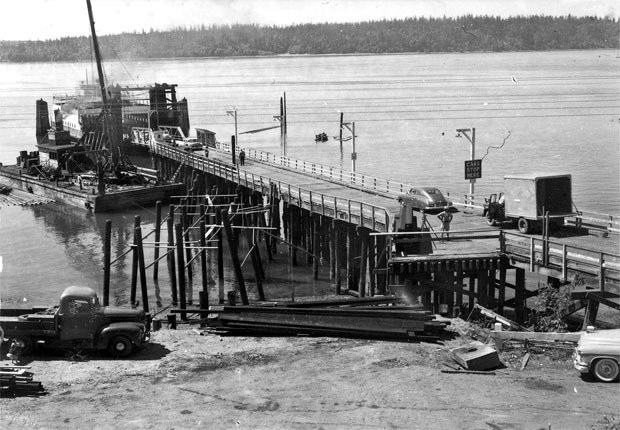The first account we have of Clam Cove, now known as Tahlequah, comes from Lt. Georges Colvocoresses of the Wilkes American Exploring Expedition, whose name was shortened to Colvos by his companions and after whom Colvos Passage is named.
On the evening of May 10, 1841, when the Wilkes expedition anchored at the south end of Vashon, Colvocoresses wrote: “At sunset we came to under the western shore to wait for daylight. It was a rich treat to behold the sublime prospect around us through all its transitions of sunshine, purple hues, mellow twilight and every shade, until there was nothing else to see but the dark loom of Mounts Rainier and Olympus, uplifting themselves against the clear and starry skies of this region.”
Settlers began to inhabit Clam Cove in the 1880s, and the first ferry began in 1916. Ira Case, who owned the Marjesira Inn at Magnolia, published a newspaper at Burton, served as a state representative and was a persistent voice for developing the road from Burton to Magnolia in 1925 and then to Tahlequah in 1932.
In 1918, Pierce County built a dock at Point Defiance for a proposed ferry to Gig Harbor and Vashon and received a promise from the King County commissioners that they’d build a dock and road to Vashon’s south end within one year.
On May 15, 1920, the Tahlequah-Point Defiance-Gig Harbor ferry service began with a celebration attended by 300 people. The ferry “City of Tacoma” was the first vessel, with a fare of 5 cents.
The Tacoma Chamber of Commerce sponsored a contest with a $50 prize to name the new south-end terminal. The prize committee included M. F. Shaw of Shawnee, Fanny Sheffield of Southern Heights and Mrs. Pankratz of Burton, whose first name could not be obtained.
The committee selected Ethel Whitfield, daughter of the owners of the Burton Store, as winner for proposing the name Tahlequah after the Oklahoma city that was the capitol of the Cherokee Nation.
Whitfield thought the word Tah-le-quah meant “water view” or “pleasant water.” In actuality, the name more likely comes from the name Chalequa for the Cherokee Tribe, which is found on a 1597 map.
P. Monroe Smock, editor of the Vashon Island News-Record, read an original poem titled “Vashon Isle” at the terminal’s opening.
Printed in the May 20, 1920, Vashon Island News-Record, the poem read in part:
“It’s Vashon Isle for ferrys (we believe in them hurrah!)
Spell them fairies after Peter Pan, or call it Tahlequah.”
The Skansie brothers from Gig Harbor operated the Tahlequah ferry using the ferry “Skansonia” until Washington State Ferries was formed in 1951 and took over operation of the ferry.
In 1958, the state ferry system began a project to rebuild the Tahlequah ferry dock, seen in the historical photograph. The “Y” in the dock that separated traffic to the east and west was removed, and the shore end of the dock was moved to the east, creating the curve that distinguishes the dock today. The small passenger shelter sits on the right side of the dock and the ticket taker booth sits on the left. The Washington State Ferries vessel “Olympic” is docked as construction takes place.
The current photograph shows the dock in 2009 with the security gate installed after Sept. 11, 2001, a significantly expanded passenger shelter moved to the left side and expanded storage for ferry equipment on the right. The dock is significantly wider, and a walk-on passenger walkway was added on the left side of the dock.
— Bruce Haulman is an Island historian. Terry Donnelly is a landscape photographer.


